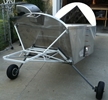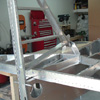


random user submitted photo
Being Seen Out There--Or Not.
7 posts
• Page 1 of 1
Being Seen Out There--Or Not.
I've had a couple of instances recently that helped reinforce the idea that many of the folks we're sharing the skies with might be having a hard time seeing our little airplanes. A couple of days ago I was sharing the pattern with a C-172 and it was fairly obvious he didn't see me despite my frequent radio calls. Finally, with him on downwind and 10 seconds after I made my turn to base, he asked again where I was ("at your 11 O'clock, slightly low. Wait 15 seconds to make your base turn and I won't be a factor"). I talked to him later and it turned out that it was an instructor and student ("we just never saw you"). Another person flying my plane in the pattern with two F-18s also was unobserved and helped steer them onto his position with some radio calls.
My plane is (kinda) polished metal and has bright yellow cowl and plastic parts. It has wingtip strobes. Of course we are small aircraft, but I suspect a low-wing plane is a bit less visible in planform than a high wing because the wing area is broken up by the fuselage (one big surface is more easily spotted than two smaller ones).
Knowing this, I:
-- Try to be extra vigilant in my scan. I'll probably have an easier time seeing "him" than he'll have in seeing me.
-- Use the radio. Monitor for other traffic so I can get a heads up, and I make calls in the pattern. I know this is controversial in some quarters (A radio isn't required! People need to use their eyes!) and I am careful to keep my calls brief, but I do make calls when in the pattern to help folks know I'm up there.
-- Keep the nav lights/strobes/landing light on.
That's it, nothing very profound I guess.
My plane is (kinda) polished metal and has bright yellow cowl and plastic parts. It has wingtip strobes. Of course we are small aircraft, but I suspect a low-wing plane is a bit less visible in planform than a high wing because the wing area is broken up by the fuselage (one big surface is more easily spotted than two smaller ones).
Knowing this, I:
-- Try to be extra vigilant in my scan. I'll probably have an easier time seeing "him" than he'll have in seeing me.
-- Use the radio. Monitor for other traffic so I can get a heads up, and I make calls in the pattern. I know this is controversial in some quarters (A radio isn't required! People need to use their eyes!) and I am careful to keep my calls brief, but I do make calls when in the pattern to help folks know I'm up there.
-- Keep the nav lights/strobes/landing light on.
That's it, nothing very profound I guess.
Mark Waldron
Sonex 1230 (Builder: Jay Gibbs)
Aerovee, Trigear
Sonex 1230 (Builder: Jay Gibbs)
Aerovee, Trigear
- vigilant104
- Posts: 265
- Joined: Wed Nov 09, 2011 3:34 pm
- Location: Near Dayton, OH
Re: Being Seen Out There--Or Not.
This is an excellent post Mark. I couldn't agree more; like you said, our airplanes are fairly small and easy to miss. Being extra vigilant in the airport environment is a great idea, as well as using the excellent visibility the Sonex offers.
I follow the same guidelines as you; I will turn on my LED strobe and nav lights before I take the runway for departure, and turn them back off after I clear the runway.
Thanks for posting Mark. I'm glad the F-18's finally saw your airplane; hopefully you got some good formation practice in with them! Did you say you've got someone else checked out in your Sonex?
I follow the same guidelines as you; I will turn on my LED strobe and nav lights before I take the runway for departure, and turn them back off after I clear the runway.
Thanks for posting Mark. I'm glad the F-18's finally saw your airplane; hopefully you got some good formation practice in with them! Did you say you've got someone else checked out in your Sonex?
Mike Farley
Waiex #0056 - N569KM (sold)
Onex #245
Waiex #0056 - N569KM (sold)
Onex #245
- MichaelFarley56
- Posts: 1485
- Joined: Thu Jun 02, 2011 11:38 pm
- Location: Columbus, Ohio
Re: Being Seen Out There--Or Not.
MichaelFarley56 wrote: I'm glad the F-18's finally saw your airplane; hopefully you got some good formation practice in with them! Did you say you've got someone else checked out in your Sonex?
Mike,
No, the F-18 encounter happened when Erick, the instructor who gave me transition training into the Sonex, was flying the plane after I bought it. He was in the plane solo and took it near Ft Worth NAS JRB. When the F-18 crews finally saw the Sonex they told the tower it "looked like a bug." Well . . . you're the one flying a "Hornet"!
Mark Waldron
Sonex 1230 (Builder: Jay Gibbs)
Aerovee, Trigear
Sonex 1230 (Builder: Jay Gibbs)
Aerovee, Trigear
- vigilant104
- Posts: 265
- Joined: Wed Nov 09, 2011 3:34 pm
- Location: Near Dayton, OH
Re: Being Seen Out There--Or Not.
Paint a big orange stripe down the side ... that'll help:
https://s3.amazonaws.com/expercraft/dal ... 631da3.jpg
8~)
Dale
N319WF
https://s3.amazonaws.com/expercraft/dal ... 631da3.jpg
8~)
Dale
N319WF
-

daleandee - Posts: 877
- Joined: Fri Feb 01, 2013 6:14 pm
Re: Being Seen Out There--Or Not.
John Gillis
SEL Private, Comm Glider, Tow pilot (Pawnee Driver)
Waiex N116YX, Jabiru 3300, Tail dragger,
First flight, 3/16/2013. 403 hours and climbing.
Home: CO15. KOSH x 5
Flying a B-Model Conversion (Super Bee Baby!)
-

fastj22 - Posts: 1594
- Joined: Sun Aug 21, 2011 5:56 pm
- Location: Mile High
Re: Being Seen Out There--Or Not.
Now that's funny right there ... I don't care who you are!
8~)
Dale
N319WF
PS: Myunn is now "Off The Chain" with her phase one completed! Hope to see many of you at Crossville ...
8~)
Dale
N319WF
PS: Myunn is now "Off The Chain" with her phase one completed! Hope to see many of you at Crossville ...
-

daleandee - Posts: 877
- Joined: Fri Feb 01, 2013 6:14 pm
Re: Being Seen Out There--Or Not.
daleandee wrote: Hope to see many of you at Crossville ...
I hope we ALL see each other--so we don't swap paint in the pattern!
The orange stripe probably helps, but most folks probably find Myun by the throaty roar of that mighty 'vair motor.
Mark
Mark Waldron
Sonex 1230 (Builder: Jay Gibbs)
Aerovee, Trigear
Sonex 1230 (Builder: Jay Gibbs)
Aerovee, Trigear
- vigilant104
- Posts: 265
- Joined: Wed Nov 09, 2011 3:34 pm
- Location: Near Dayton, OH
7 posts
• Page 1 of 1
Who is online
Users browsing this forum: No registered users and 71 guests







